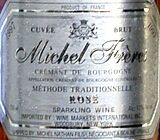|
Crémant de Bourgogne
The wine looks like Champagne, with its wire cage around a mushroom-shaped cork that comes out with a pop. It pours with a frothy mousse that rises up in the glass, then falls back to reveal a bubbly Champagne-style beverage that's prickly, crisp and dry. It's French, all right, but it's not Champagne, with no more right to bear that name than any sparkling wine produced in California, Australia or anywhere else but the specific region of that name around the French cities Reims, Epernay and environs. Meet Crémant ("Cray-mawn"), a category of French sparkling wine whose name has been a moving target in recent years. Literally translated as "creaming," the word used to apply to a less-bubbly style of Champagne, one that poured with a gentle fizz. But since international treaties and European Union regulations have more strictly forbade the use of "Champagne" and "methode champenoise" for any wines but those made in Champagne, "Crémant" has been reinvented as the term of art for sparkling wines made by the traditional Champagne process in other parts of France. As early as the 1970s, Crémant was established as a formal category for sparkling wines from Burgundy, Alsace and the Loire. More have followed, from less well-known regions such as Limoux and Die; there's even a sparkling Crémant from Bordeaux. I report today on a Cremant de Bourgogne, a pink sparkling wine made entirely from Pinot Noir in Burgundy, where sparkling wine may be made from any of the grapes permitted in the region's still wines. A rich, dry and tart sparkler of very high quality, it's a far cry from the modest American and Australian bubblies that used to be sold as "Sparkling Burgundy." Speaking of those bad old days, some of you may be wondering why we still occasionally see sparkling wines of U.S. origin unabashedly bearing "Champagne" on the label. The United States, it seems, has never signed on to the international treaty limiting use of the term - it was originally negotiated during Prohibition, when the sale of alcoholic beverages was forbidden throughout the country. Since then, political pressure from larger mass-market wine companies has blocked any effort to bar American producers from using such "generic" European wine names as Champagne, Burgundy and Chablis. One maker of American "Champagne," Korbel, points out that its wines have been made under that name since the 1880s, arguing that its use of the name would be "grandfathered" even if the treaty applied. Others, including Gallo's André brand of inexpensive sparkling wine, simply use the name without apology. In Australia, conversely, economic pressure from the EU prompted widespread compliance during the early 1990s, when Aussie producers universally stopped calling their sparkling wines "Champagne" or "Sparkling Burgundy," and Penfolds dropped the French "Hermitage" from its storied Grange.
TELL US WHAT YOU THINK If you have a tasting note on a Crémant that you would like to share, please post it as a new forum topic beginning with the code "TN:" so it will be included in our permanent tasting-notes archives. If you prefer to comment privately, feel free to send me E-mail at wine@wineloverspage.com. I'm sorry that the overwhelming amount of mail I receive makes it tough to respond personally every time, but I do try to get back to as many as I can.  Michel Frères 1997 Crémant de Bourgogne Rosé Cuvée Brut ($15.59)
Michel Frères 1997 Crémant de Bourgogne Rosé Cuvée Brut ($15.59)
A dry sparkler but not a Champagne, this delightfully fizzy pink wine is made by the Champagne process (individually fermented in the bottle) in France's Burgundy region. Made from 100 percent Pinot Noir, it's one of the best bubbly bargains around. Clear, pale copper in color, its light, frothy mousse drops back quickly, leaving few visible bubbles in the glass. Delicious subtle red-berry fruit aromas add a distinct edge of cocoa, a common and appealing quality in Pinot-based sparklers. Its rich and creamy mouthfeel shows a prickly edge, carbonation more apparent in the mouth than in the glass. Berry and cocoa flavors mirror the nose, smooth and full, very dry and appropriately tart. Serves well with food, or for sipping alone or raising a holiday toast. U.S. importer: Wine Markets International Inc., Woodbury, N.Y. (Dec. 11, 2003) FOOD MATCH: Its dry, tart yet rich flavor profile will marry with a broad range of foods; it was first-rate with a simple chicken sautee with a pan sauce of butter and lemon. VALUE: Excellent value at this mid-teens point; fully comparable with Champagnes at twice the price. WHEN TO DRINK: This six-year-old vintage is going strong; more recent bottlings now in the market should hold up well for years.
FIND THIS WINE ONLINE: Locate vendors and compare prices of Michel Fréres on Wine-Searcher.com: Administrivia To subscribe or unsubscribe from The 30 Second Wine Advisor, change your E-mail address, or for any other administrative matters, please use the individualized hotlink found at the end of your E-mail edition. If this is not practical, contact me by E-mail at wine@wineloverspage.com, including the exact E-mail address that you used when you subscribed, so I can find your record. We do not use our E-mail list for any other purpose and will never give or sell your name or E-mail address to anyone. I welcome feedback, suggestions, and ideas for future columns. To contact me, please send E-mail to wine@wineloverspage.com All the wine-tasting reports posted here are consumer-oriented. In order to maintain objectivity and avoid conflicts of interest, I purchase all the wines I rate at my own expense in retail stores and accept no samples, gifts or other gratuities from the wine industry.
Friday, Dec. 12, 2003 |





